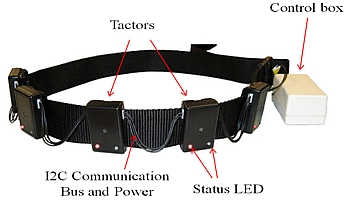
Haptic Belt
Contact
Members
Dr. Sethuraman "Panch" Panchanathan
Dr. Sethuraman "Panch" Panchanathan
Dr. Troy L. McDaniel
Dr. Troy L. McDaniel
Recently, much research in the area of haptic technologies has focused on the development of waist-worn haptic belts, also known as vibrotactile or vibration belts, as a substitution or augmentation modality for audio-visual information. Vibrotactile belts have been used in varied applications such as navigational aids, spatial orientation displays and balance control systems. Researchers have mostly focused on the functionality of these vibrotactile belts for specific applications, while neglecting performance and usability design considerations. We've proposed design requirements that, when followed, will aid in the development of a versatile, usable haptic belt. The image depicts a haptic belt we've constructed following these design requirements. Since its implementation, it has been successfully used in a number of applications including choreographed dance instruction, audio-haptic described movies and social interaction assistance for individuals who are blind. As part of future research, we are further assessing the usability of the belt in different applications, and exploring how the proposed design requirements translate to other vibrotactile wearables.
Funding Sources
AFRL (Air Force Research Laboratories) BAA, HANSCOM AFB, FA8721-10-C-0002








